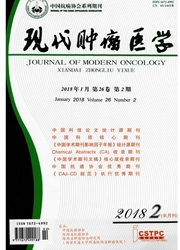

 中文摘要:
中文摘要:
目的:解析骨髓间充质干细胞(MSCs)作为组织工程种子细胞的自发恶性转化的分子遗传学基础,探讨其临床可用性和安全性。方法:密度梯度离心法和贴壁筛选法联合应用,分离大鼠MSCs,流式细胞仪分析细胞同源性,体外培养6个月后获得自发恶性转化的MSCs。Trizol总RNA抽提法获取足量的RNA,用于MSCs基因表达谱的分析。实时定量RT—PCR法对在自发恶性转化的MSCs中呈差异表达的基因进行扩增和检测,以验证基因芯片分析结果。结果:流式细胞仪检测表明了所分离MSCs的高度同源性。MSCs发生自发恶性转化后,有44条差异表达基因,其中21条基因表达上调,23条基因表达下调。经实时定量RT—PCR检测差异表达基因结果与基因芯片结果一致。结论:Wnt、SHH、Notch、TGFβ/BMPs等信号转导通路上的若干基因在MSCs自发恶性转化中起到重要作用。
 英文摘要:
英文摘要:
Objective: To investigate the molecular genetic basis of spontaneous transformation of mesenchymal stem cells (MSCs) and clinical application value of MSCs as seeding cells of tissue engineering. Methods: MSCs were isolated through the combined utilization of density gradient centfifugation and adherence screening methods. After cell homogeneity analysis was performed by flow cytometry, spontaneous transformation MSCs were isolated after six - month in vitro expansion. Then cell total RNA was obtained with Trizol reagent and studied for gene expression profile. Differentially expressed genes between nomal MSCs and spontaneous transformation MSCs in cDNA mieroarray were determined by real - time RT - PCR for validation of the microarray data. Results : FACS analysis showed high homogeneity of the separated MSCs. Forty - four genes were differentially expressed after spontaneous transformation of MSCs, among which 21 were up - regulated and 23 down - regulated. The result of real - time RT - PCR was in accordance with that of the cDNA microarray. Conclusion : Several genes in SHH, Notch, TGFβ/BMPs signal pathway play an important role in spontaneous transformation of MSCs.
 同期刊论文项目
同期刊论文项目
 同项目期刊论文
同项目期刊论文
 期刊信息
期刊信息
